Related Research Articles

Ballet is a type of performance dance that originated during the Italian Renaissance in the fifteenth century and later developed into a concert dance form in France and Russia. It has since become a widespread and highly technical form of dance with its own vocabulary. Ballet has been influential globally and has defined the foundational techniques which are used in many other dance genres and cultures. Various schools around the world have incorporated their own cultures. As a result, ballet has evolved in distinct ways.

August Bournonville was a Danish ballet master and choreographer. He was the son of Antoine Bournonville, a dancer and choreographer trained under the French choreographer, Jean Georges Noverre, and the nephew of Julie Alix de la Fay, née Bournonville, of the Royal Swedish Ballet.

Choreography is the art or practice of designing sequences of movements of physical bodies in which motion or form or both are specified. Choreography may also refer to the design itself. A choreographer is one who creates choreographies by practising the art of choreography, a process known as choreographing. It most commonly refers to dance choreography.
Because ballet became formalized in France, a significant part of ballet terminology is in the French language.
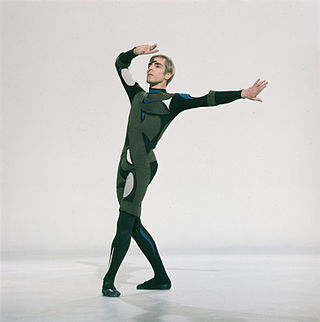
Erik Belton Evers Bruhn was a Danish danseur, choreographer, artistic director, actor, and author.

Pointe technique is the part of classical ballet technique that concerns pointe work, in which a ballet dancer supports all body weight on the tips of fully extended feet within pointe shoes. A dancer is said to be en pointe when the dancer's body is supported in this manner, and a fully extended vertical foot is said to be en pointe when touching the floor, even when not bearing weight.
Ballet technique is the foundational principles of body movement and form used in ballet. It is an important aspect of ballet performance because ballet puts great emphasis on the method and execution of movement. The techniques found in classical ballet are a framework for many other styles of dance, including jazz and contemporary ballet.
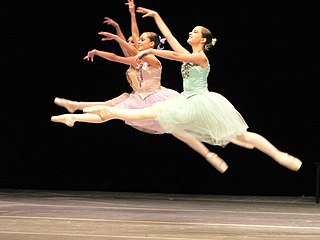
A ballet dancer is a person who practices the art of classical ballet. Both females and males can practice ballet; however, dancers have a strict hierarchy and strict gender roles. They rely on years of extensive training and proper technique to become a part of a professional ballet company. Ballet dancers are at a high risk of injury due to the demanding technique of ballet.
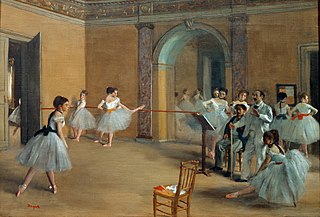
Classical ballet is any of the traditional, formal styles of ballet that exclusively employ classical ballet technique. It is known for its aesthetics and rigorous technique, its flowing, precise movements, and its ethereal qualities.
La Sylphide is a romantic ballet in two acts. There were two versions of the ballet; the original choreographed by Filippo Taglioni in 1832, and a second version choreographed by August Bournonville in 1836. Bournonville's is the only version known to have survived and is one of the world's oldest surviving ballets.
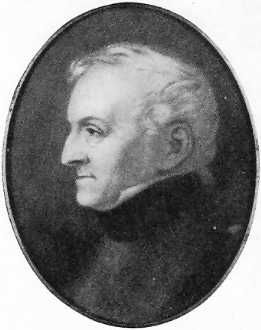
Filippo Taglioni was an Italian dancer and choreographer and personal teacher to his own daughter, Romantic ballerina Marie Taglioni. Also, although August Bournonville's version is better known, it was Taglioni who was the original choreographer of La Sylphide, in 1832.

Carlo Blasis was an Italian dancer, choreographer and dance theoretician born in Naples. He is well known for his very rigorous dance classes, sometimes lasting four hours long. He danced in France, Italy, London and Russia. Blasis insisted that his students learn theories and definitions of dance steps. He trained all of Enrico Cecchetti's teachers and it is thought that Blasis's influence in his training is what led Cecchetti to create the Cecchetti method of ballet.
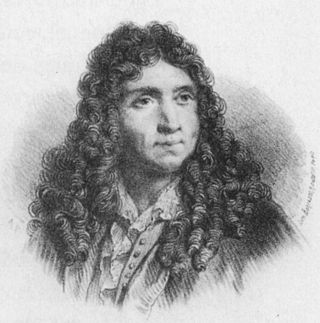
Pierre Beauchamp or Beauchamps was a French choreographer, dancer and composer, and the probable inventor of Beauchamp–Feuillet notation. His grand-father was called Christophe and his father, a violinist of the king's chamber, was simply called Louis. Following a custom of the time, Pierre Beauchamp was named Pierre after his godfather Pierre Vacherot, tailor of the queen's pages and a relative of the Beauchamps family.

A barre is a stationary handrail that provides support for people during various types of exercise. Barres are used extensively in ballet training and warm up exercises, where such exercises are commonly referred to as barre work. In a ballet class, barre may also refer to the part of the class that involves barre work. Barres are also used for warm up exercises in other types of dance, as well as in general fitness programs.
Grotesque dance is a category of theatrical dance that became more clearly differentiated in the 18th century and was incorporated into ballet, although it had its roots in earlier centuries. As opposed to the danse noble or "noble dance" performed in royal courts which emphasized beauty of movement and noble themes, grotesque dances were comic or lighthearted and created for buffoons and commedia dell'arte characters to amuse and entertain spectators or patrons. In 16th and 17th centuries grotesque dances were often presented as an anti-masque, performed between the acts of more serious courtly entertainments. Likewise, the 17th century entrée de ballet sometimes contained grotesque sequences, most notably those devised by the Duke of Nemours for the court of Louis XIII.

The Flower Festival in Genzano is a one-act ballet by Danish choreographer and ballet master August Bournonville (1805–1879). Bournonville created the work for Denmark's Royal Ballet on December 19, 1858, at the Royal Danish Theatre, on the basis of Danes' general enthusiasm for Italy. The libretto, which is adapted from a tale in Impressions de voyage by Alexandre Dumas, tells the story of a pair of young lovers, Rosa and Paolo, which alludes to the festival still celebrated each June in Genzano, Italy. The music is by Edvard Helsted and Holger Simon Paulli.

Arabesque in dance, particularly ballet, is a body position in which a dancer stands on one leg–the supporting leg–with the other leg–the working leg–turned out and extended behind the body, with both legs held straight.
The positions of the feet in ballet is a fundamental part of classical ballet technique that defines standard placements of feet on the floor. There are five basic positions in modern-day classical ballet, known as the first through fifth positions. In 1725, dancing master Pierre Rameau credited the codification of these five positions to choreographer Pierre Beauchamp. Two additional positions, known as the sixth and seventh positions, were codified by Serge Lifar in the 1930s while serving as Ballet Master at the Paris Opéra Ballet, though their use is limited to Lifar's choreographies. The sixth and seventh positions were not Lifar's inventions, but revivals of positions that already existed in the eighteenth century, when there were ten positions of the feet in classical ballet.
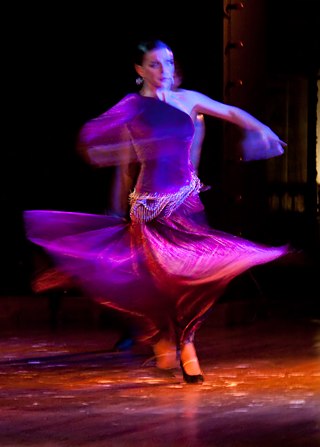
In dance and gymnastics, a turn is a rotation of the body about the vertical axis. It is usually a complete rotation of the body, although quarter (90°) and half (180°) turns are possible for some types of turns. Multiple, consecutive turns are typically named according to the number of 360° rotations.

In ballet, battement is an alternating side-to-side movement of the working leg. Battements are typically performed in multiples, quickly and in rapid succession so that the working foot appears to be fluttering or vibrating. They are usually executed in front, to the side or in back The word battement is of French origin, meaning "beat".
References
- ↑ "Guide to the danish golden age - August Bournonville". Archived from the original on 2011-07-19. Retrieved 2010-07-19.
- 1 2 3 "Bournonville.com". www.bournonville.com.
- 1 2 3 4 5 6 7 "Bournonville.com". www.bournonville.com.
- 1 2 "August Bournonville - Everything2.com". everything2.com.